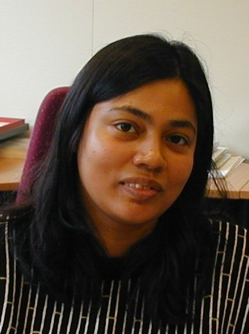Chemically modified ceramic membranes; study of structural and transport properties.
Promotion Date: 3 March 2006
| The group here has been working on ceramic membranes (inorganic silica membranes). My project involved modifying the top layer, making it more hydrophobic to enhance separation properties of gases and liquids. Because silica is a hydrophilic material it absorbs water from the atmosphere blocking the pores of the silica. |
What was your thesis about?
The group here has been working on ceramic membranes (inorganic silica membranes). My project involved modifying the top layer, making it more hydrophobic to enhance separation properties of gases and liquids.
Why do you need to make the layer hydrophobic ?
Because silica is a hydrophilic material: it absorbs water from the atmosphere blocking the pores of the silica. If we could have a system that is hydrophobic it would be much better. If you would work at a higher temperatures, the problem with water blocking the pores would also be solved, but if you look at the long term use of economic applications in industry this higher temperature is a decided disadvantage.
What did you achieve?
We took a precursor (a reagent chemical) that has a hydrophobic property (methyltriethoxysilane instead of the tetraethoxysilane that is normally used). It repels water. We were mixing the two reagents and the hydrophobic character was retained. It has been done before, but we went a few steps further, using different reagents. It was found that with higher temperatures (950 C) the network was degrading. In my thesis we worked with BTESE. That worked up to a temperature of 1500 C for an extended period of 6 months, which is remarkable as compared to the other systems. Our system is a hybrid structure, with mixed hydrophilic and hydrophobic properties. We can use this system now and tune it to our needs. That was the important part of my thesis. We came upon a basic recipe that will hold well in the future.
You are from India. What made you decide to do a PhD at Mesa+?
After my Master’s I was working for Unilever; it has a research centre in Bangalore. I had been working there for two years. There was a lot of collaboration with the labs here. That is how I came to know about the Netherlands, and I was also interested in further studies. I applied to a vacancy in the group and I was called for an interview.
You travelled to here for the interview?
Yes. But then I could only join after 10 months because my visa took such a long time.
What did you think?
When I finally arrived everything went smoothly. It was just the visa that was a problem. Once I came here it was nice, I really enjoyed my stay. I liked campus life so much that I didn’t even look for accommodation in the city.
Have you been to conferences?
In my first year I have been to the Membrane summer school in Trondheim, Norway and then in my second year I visited St Petersburg; there was a conference on nano materials and in the last year I have been to California. In some I had an oral presentation and in others I presented a poster.
Any publications?
We put a hold on the publications for a while because we wanted to patent the membrane. But this January we got the patent and we will hopefully have publications shortly.
What will you do next?
I will have a break for about two months. I have applied for post docs in Europe, also in the Netherlands, but it takes time apparently. But as it is I am happy with my break.

